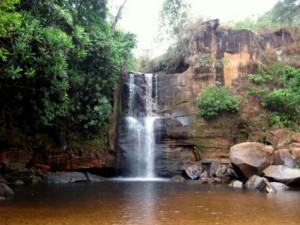
Photo © Michael Sommers.
It’s a strange sensation to knowingly set off on a journey into an area under siege by fire, but that’s precisely what my sister, Annie, and I did when we set off for Chapada dos Guimarães, from Cuiabá, the capital of Mato Grosso.
Actually, Chapada dos Guimarães, the former diamond mining town, population 18,000, where we had reserved three nights’ accommodation wasn’t in danger of going up in flames. However, word had it that much (just how much varied significantly depending on the information source) of the surrounding Cerrado forest and scrub land – a large portion of which was supposedly safely preserved within the borders of the Parque Nacional da Chapada dos Guimarães (whose natural attractions were the prime reason for our visit) – had been torched to the ground.
At first, the fires seemed insignificant and far away, but as we grew closer to our final destination, we were shocked to see bursts of flames raging right in front of the highway.We dallied much of the morning away in Cuiabá, under a milky colored sky whose sun was obscured by smoke. Finally, in the late afternoon, with a mixture of anticipation and trepidation, we boarded a Rubi Express bus bound for Chapada dos Guimarães. As the bus wound its way up out of the city outskirts and into the initial mixture of palms, grasses, low-lying trees, and lofty ipês (some with vivid sprays of purple and yellow blossoms) that characterize the Cerrado vegetation of Brazil’s Central-West, we let out cautious sighs of relief. Perhaps reports of the damage – such as those offered by the caipirinha-sloshed Swiss woman whose company we’d shared the previous night – had been exaggerated. However, as the elevation rose, we began to see the first signs of catastrophe: blackened earth, scorched grasses, skeletal trees.
The sudden and seemingly arbitrary zones of devastation – rendered all the worse by the stark monochromatic hues that had invaded a region known for its lush exuberance – were shocking to behold. It was even more frightening, however, when we entered the zone of rugged cliffs, steep valleys, and rocky outcrops that signaled the beginning of the Chapada dos Guimarães (“chapada” refers to the elevated, rocky, plateaus found in Brazil’s Central-West and Northeast). Plumes of smoke wafted across the valleys like angry clouds and orange-gold fireballs conjured up enemy bombs as much as burning brush.
At first, the fires seemed insignificant and far away, but as we grew closer to our final destination, we were shocked to see bursts of flames raging right in front of the highway. When the bus drove by a famous lookout point with the name of Portão de Inferno (Gates of Hell), we stared, in horror and wonder, beyond the abyss to an apocalyptic vision of charred forests, ash-covered earth, and dancing flames; it did indeed feel as if we were gazing out at a living version of Hell.
As the bus drew into the reassuringly leafy green town of Chapada dos Guimarães, the sky was not only dark with smoke, but with dusk – and with rain. Yes, as we alighted from our bus we felt the refreshing surprised of fast wet drops spilling down upon our faces. All the passengers clambering off our bus, along with others huddled around the tiny green rodoviária, were buzzing about the unexpected and exceedingly welcome precipitation. At our pousada, the cozy Hotel Turismo, we were told that this rain – the first in over 60 days – was welcome, and could possibly have some effect on the fires, but certainly wouldn’t last since it wasn’t quite yet the end of the long dry season.
And yet the next morning, we awoke to skies that were grey – not due to smoke, but to curtains of rain. As the morning wore on, it slowed to drizzle, and escalated to downpour, but never ceased – much to the surprise (and relief) of the Chapadenses to whom we put the question: “How long is it going to last?”
When we asked around town about possible attractions to visit, we were told that the Parque Nacional da Chapada dos Guimarães, which can only be visited with a guide, was still closed – due to fire. Fire was also responsible for the closure of the region’s biggest single attraction: the magnificent 86-meter high Véu de Noiva (Bridal Veil) waterfall. Meanwhile, rain, and a thick accompanying mist (which had replaced the smoke) nixed the idea of a visit to either Mirante or Morro dos Ventos (two panoramic lookouts with jaw-dropping, all-encompassing views of the cliffs and valleys surrounding the Chapada).
Between fire and rain, there was little left for us to do, but curl up in our beds and read… but then the owner of our pousada suggested we visited Cachoeirinha. Not only was this “little waterfall” located outside of the national park, but it was also out of the line of fire – and easily accessible by bus (the same Rubi Express that had brought us from Cuiabá). Best of all: in the event the rain really starting coming down, Cachoerinha boasted a celebrated restaurant overlooking the falls that was famed its preparation of traditional Mato Grossense dishes.
It might seem weird to spend a cold, grey, rainy, Saturday afternoon at a waterfall – but that’s exactly what we did. Although we didn’t go swimming, we did have fun wading around amidst the rocky shelves draped with wild ferns and orchids. And instead of the usual Saturday hordes, we had the falls – and the charmingly rustic restaurant where we feasted on peixe na telha (thick tender chunks of local pintado (catfish) cooked in a fragrant manioc sauce, and served in the ceramic roofing tile (telha) in which it was baked) – entirely to ourselves.
It might sound trite, but the lesson reinforced was that, regardless of whether clouds are formed by smoke or by rain, there is always a silver lining.